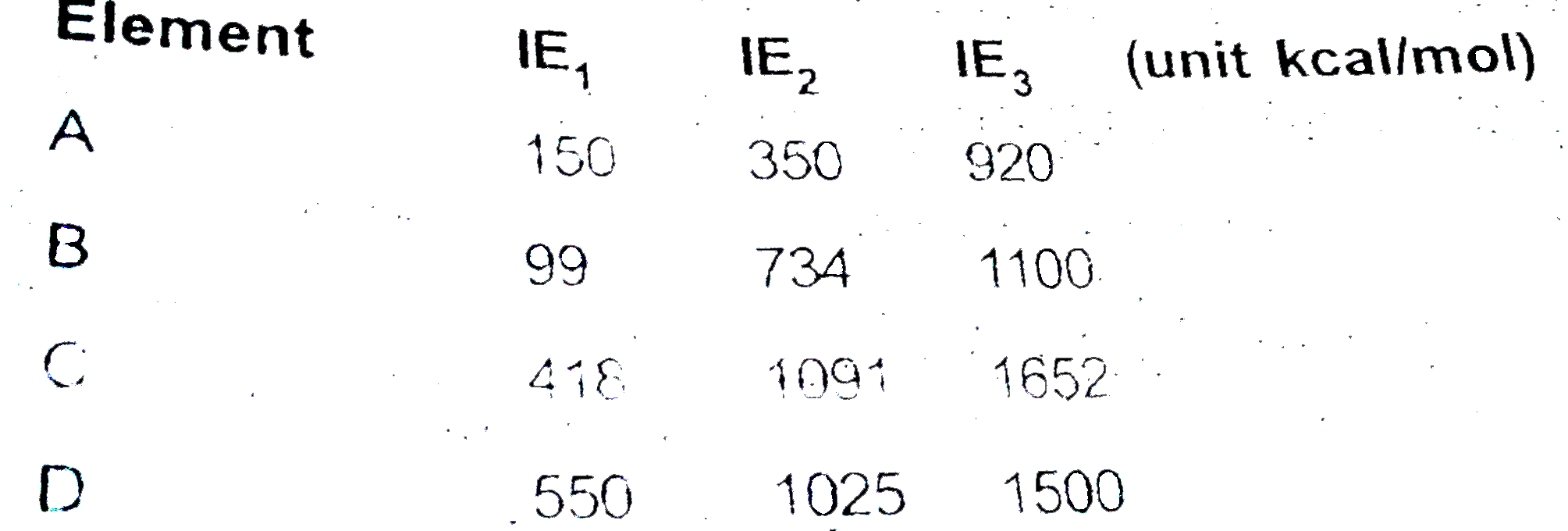The value of IE1,IE2,IE3 and IE4 of an atom are respectively 7.5eV,25.6eV,48.6eV and 170.6eV. The electronic configuration of the atom will be
1s2,2s22p6,3s1
1s22s22p63s23p1
1s2,2s22p63s23p3
1s2,2s22p63s2
The correct Answer is:B
To determine the electronic configuration of the atom based on the provided ionization energies (IE), we can follow these steps:
Step 1: Analyze the Ionization Energies
We have the following ionization energies:
- IE1=7.5eV
- IE2=25.6eV
- IE3=48.6eV
- IE4=170.6eV
Step 2: Calculate the Differences Between Ionization Energies
Next, we will calculate the differences between consecutive ionization energies to identify trends:
- Difference between IE1 and IE2:
25.6−7.5=18.1eV
- Difference between IE2 and IE3:
48.6−25.6=23.0eV
- Difference between IE3 and IE4:
170.6−48.6=122.0eV
Step 3: Identify the Significant Increase in Ionization Energy
From the differences calculated:
- The first and second ionization energies have a moderate increase.
- The second and third ionization energies also show a moderate increase.
- However, there is a significant jump in the energy required to remove the fourth electron (from 48.6 eV to 170.6 eV).
Step 4: Conclusion on Valence Electrons
The large increase in ionization energy from IE3 to IE4 suggests that after removing three electrons, the atom reaches a stable electronic configuration, likely resembling that of a noble gas. This indicates that the atom has three valence electrons.
Step 5: Determine the Electronic Configuration
Elements with three valence electrons typically belong to Group 13 of the periodic table. The electronic configuration for an element with three valence electrons (like Aluminum, which has the configuration of (Ne)3s23p1) can be represented as:
Electronic Configuration: (Ne)3s23p1
Final Answer
The electronic configuration of the atom is (Ne)3s23p1.
---
We have the following ionization energies:
- IE1=7.5eV
- IE2=25.6eV
- IE3=48.6eV
- IE4=170.6eV
Next, we will calculate the differences between consecutive ionization energies to identify trends:
- Difference between IE1 and IE2:
25.6−7.5=18.1eV
- Difference between IE2 and IE3:
48.6−25.6=23.0eV
- Difference between IE3 and IE4:
170.6−48.6=122.0eV
From the differences calculated:
- The first and second ionization energies have a moderate increase.
- The second and third ionization energies also show a moderate increase.
- However, there is a significant jump in the energy required to remove the fourth electron (from 48.6 eV to 170.6 eV).
The large increase in ionization energy from IE3 to IE4 suggests that after removing three electrons, the atom reaches a stable electronic configuration, likely resembling that of a noble gas. This indicates that the atom has three valence electrons.
Elements with three valence electrons typically belong to Group 13 of the periodic table. The electronic configuration for an element with three valence electrons (like Aluminum, which has the configuration of (Ne)3s23p1) can be represented as:
Electronic Configuration: (Ne)3s23p1
The electronic configuration of the atom is (Ne)3s23p1.
Topper's Solved these Questions
- BOOK - CENGAGE CHEMISTRYCHAPTER - PERIODIC CLASSIFICATION OF ELEMENTS AND GENERAL INORGANIC CHEMISTRYEXERCISE - Exercises (Single Correct) Isoelectronic Species4videos
PERIODIC CLASSIFICATION OF ELEMENTS AND GENERAL INORGANIC CHEMISTRY
- BOOK - CENGAGE CHEMISTRYCHAPTER - PERIODIC CLASSIFICATION OF ELEMENTS AND GENERAL INORGANIC CHEMISTRYEXERCISE - Exercises (Single Correct) Matallic-Non Metallic Character3videos
PERIODIC CLASSIFICATION OF ELEMENTS AND GENERAL INORGANIC CHEMISTRY
- BOOK - CENGAGE CHEMISTRYCHAPTER - PERIODIC CLASSIFICATION OF ELEMENTS AND GENERAL INORGANIC CHEMISTRYEXERCISE - Exercises (Singlecorrect) Atomic And Ionic Radii15videos
PERIODIC CLASSIFICATION OF ELEMENTS AND GENERAL INORGANIC CHEMISTRY
- BOOK - CENGAGE CHEMISTRYCHAPTER - P-BLOCK GROUP 14 - CARBON FAMILYEXERCISE - Exercises Archives (Subjective)9videos
P-BLOCK GROUP 14 - CARBON FAMILY
- BOOK - CENGAGE CHEMISTRYCHAPTER - PURIFICATION OF ORGANIC COMPOUNDS AND QUALITATIVE AND QUANTITATIVE ANALYSISEXERCISE - Assertion Reasoning Type5videos
PURIFICATION OF ORGANIC COMPOUNDS AND QUALITATIVE AND QUANTITATIVE ANALYSIS
Similar Questions
Ionisation energy is the amount of energy required to remove the outermost e− from a gaseous atom. It's unit is kJ/mole or kcal/mole.
Successive ionisation energy - It is the amount of energy required to remove electron successively from a gaseous ion. These are termed as IE2,IE3,IE4 etc. the difference in the values of IE1,IE2 and IE3 helps to determine electronic configuration of the element.

Which element is a noble gas ?View SolutionIonisation energy is the amount of energy required to remove the outermost e− from a gaseous atom. It's unit is kJ/mole or kcal/mole.
Successive ionisation energy - It is the amount of energy required to remove electron successively from a gaseous ion. These are termed as IE2,IE3,IE4 etc. the difference in the values of IE1,IE2 and IE3 helps to determine electronic configuration of the element.

Which element forms stable unipositive ion ?View Solution
Knowledge Check
- Question 1 - Select One
The value of IP1,IP3andIP4 of an atom are, respectively,
7.5 eV, 25.6 eV, 48.6 eV and 170.6 eV. The electronic configuration of the atom will be:A1s2,2s2,2p6,3s1B1s2,2s2,2p6,3s2,3p1C1s2,2s2,2p6,3s2,3p3D1s2,2s2,2p6,3s2 - Question 2 - Select One
The values of IE(I),IE(II),IE(III) and IE(IV) of an atom are respectively 7.5eV,25.6eV,48.6eV and 170.6eV. The electronic configuration of the atom will be :
A1s2,2s22p6,3s1B1s2,2s22p6,3s23p1C1s2,2s22p6,3s23p3D1s2,2s22p6,3s2 - Question 3 - Select One
The values of IE1,IE2,IE3,IE4 and IE5 of an element are 8.1, 14.3, 34.5, 46.8 and 162.2 eV respectively. The element is likely to be:
ANaBSiCFDCa
IE1,IE2 and IE3 values are 100,150 and 1500eV respectively. The element can be
View SolutionThe value of 1 eV/ atom is
View SolutionThe values of IE1,IE2,IE3,IE4 and IE5 of an element are 8.1, 14.3, 34.5, 46.8 and 162.2 eV respectively. The element is likely to be:
View SolutionThe values of IE1,IE2,IE3,IE4 and IE5 of an element are 5.98, 18.82, 28.44, 120 and 153.8 eV respectively. The element is likely to be
View SolutionThe IE1,IE2,IE3 and IE4 of an element are 5.7, 11.03, 42.89, 57 eV respectively. The element is likely to be
View Solution

